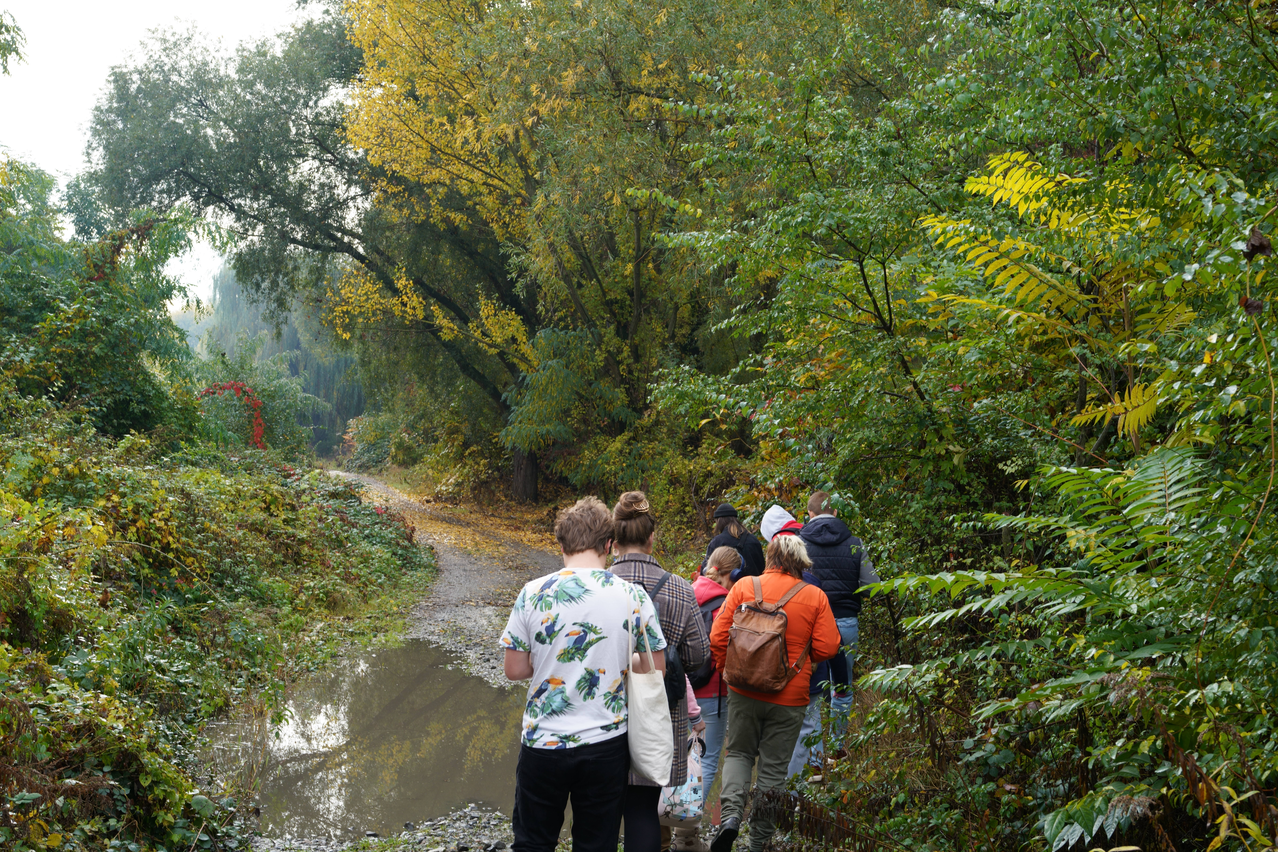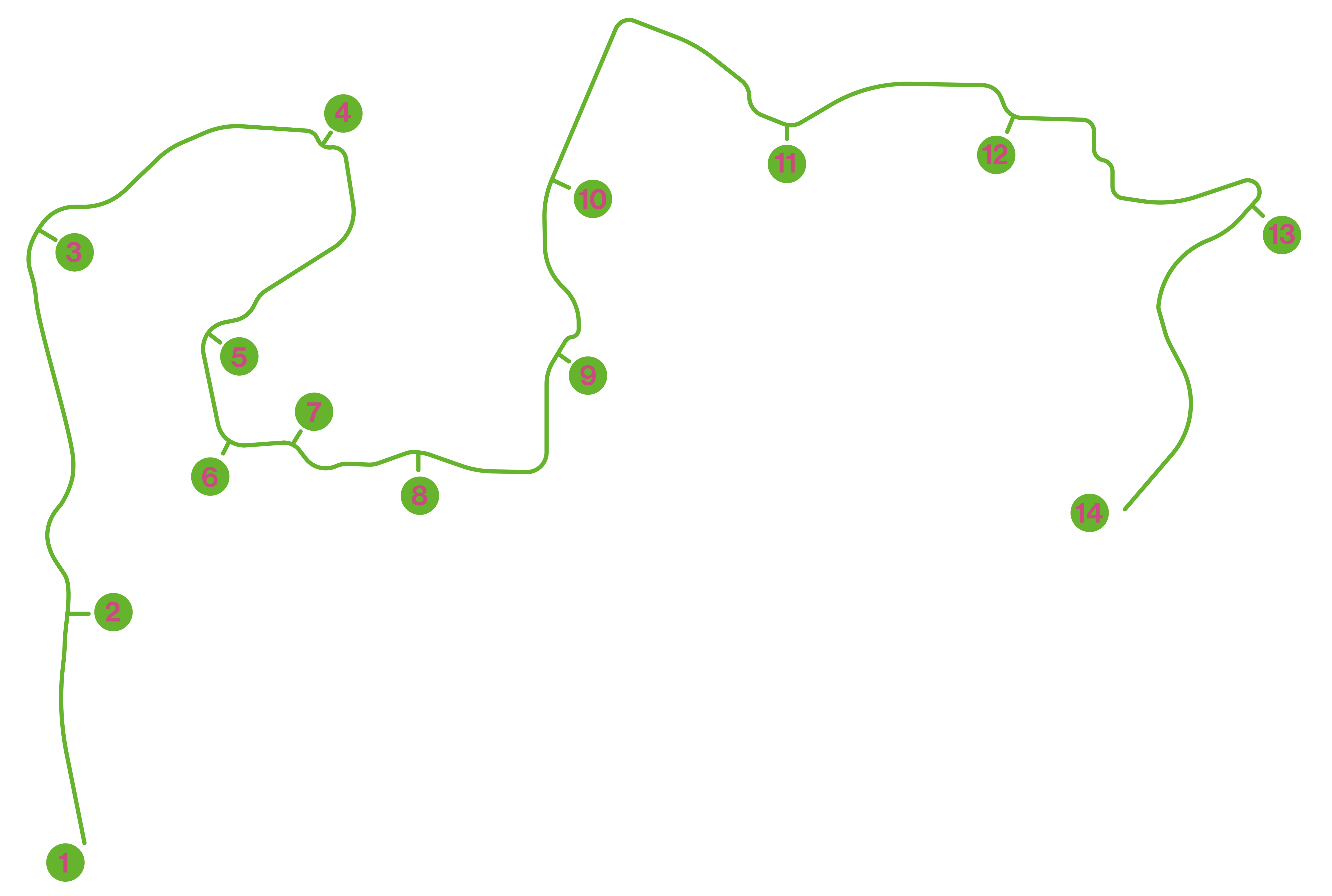Barbora Lungová
What you are going to explore is a result of a collaboration of visual artists and social anthropologists who agreed on the idea of mapping by the means adequate for their disciplines the phenomenon of spontaneous gardening in Brno. Our aim was to create an emotional map of non-traditional gardens which would offer its users insights into the motivations for gardening in open public spaces, into different forms this gardening may take, and into ways in which certain types of spaces and plants inhabiting them can be viewed from an unconventional perspective. The chief aim of the project is also the emphasis on the validity of small-scale, bottom-up interventions in public space which remind us of its origin as a common that should be possible to be shaped and to be accessed by everyone.
The resulting product is an audio guide available for the public atwww.socialmaps.app with a map of the route encompassing twelve stops with a short textual description and longer audio track accompanying each stop. The exposition that you are going to explore here is an elaboration of the walk which contains longer texts and a richer photographic documentation of the sites. The structure of the map on the second page of this exposition approximates but does not copy faithfully the actual route on socialmaps.app - it is designed in a manner which should navigate the reader on the virtual sheet. In the exposition here, you will be able to hear all twelve tracks in Czech original which are also available to the users of the audio guide via the Echoes app.
The idea of collaboration of visual artists and social anthropologists stemmed from the desire to interpret certain types of urban places which have been appropriated and transformed via unconventional gardening practice with both the language and perspectives of contemporary art and from the curiosity about motivations for creating “non-artistic” forms of gardening by people who see this practice as a part of their everyday life.
The primary motor for examining the phenomenon of spontaneous gardening stemmed from the author of this introductory text, who herself practices this type of gardening. Why do other people do it? What are the possible forms, formats, tactics? How do other gardeners perceive the place in which they do spontaneous gardening, how do they perceive the results of their actions in changing these places and their interaction with people who “consume” these results? How can art approach spontaneous gardening and highlight unthought-of aspects of gardening as an activity and the uses of public space, applying idiosyncratic, paradoxical, and sometimes dematerialized set of practices ? Is is possible to draw a clear line between artistic and non-artistic format of spontaneous, DIY gardening in public space? In order to be able to answer these questions, it seemed necessary to invite not only other artists, but also researchers from the field of social sciences who have a specific set of skills of approaching people and describing social phenomena. The aim was not to “just” have products of aesthetic character in the form of final artworks, but also some empirical data from people who are “out there” intervening in public space and do not think of themselves as artists, or at least not as artists organized within the institutionalized world of contemporary art.As for the term “spontaneous” gardening that we prefer to use instead of “guerilla gardening,” the former term does not connote the air of political radicalism that is sometimes invoked with the latter, especially in popularizing media (Richard Reynolds, n.d., Dream Green, n.d.). Not that there is anything bad with radicalism in appropriating urban public space, but the practices of non-artistic gardeners we describe in our project or the artistic practices we employ ourselves here do not accomplish such intensity so as to be understood as radical. We use the word “spontaneous” in the sense that is it used in a different, older US project named “Spontaneus Interventions” which is a database of local grass-roots initiatives that popped up in diverse cities; “spontaneous” is here used in the sense of bottom-up, (sometimes) officially unauthorized collective or community endeavors which take back and improve public space to make it more inclusive (Spontaneous Interventions, n.d.). Another association also comes to mind – that of Atlas of Spontaneous Art (Konečný and Kadlčák, 2016), which is a travel guide around the Czech Republic documenting outdoor art created by amateur (“outsider”) artists. The term “spontaneous” is in this sense understood as unconstrained by the learned norms of the professional art world, executed in a very DIY fashion.
These acts of spontaneous interventions can be perceived as everyday acts of enchanting the world. Jane Bennet claims that contrary to the claims of modernity being disenchanted, there are many aspects of our dwelling in this world which enable appreciating the secular aspects of its enchantment. She believes that seeing and appreciating enchantment needs not be only reserved for privileged people as it can be found in areas which can be available by everyone. She also stresses the element of play and the motivation to involve oneself ethically to the world that can stem from our capability to see certain phenomena as “enchanted.” It is the affective involvement with the world (wonder, awe, surprise) which propels in us a mode of “ethical generosity” (Bennet, 2001). Although Bennet deals in her account with complex phenomena, which have inscribed in them the potential to enchant us, we could argue that even a quotidian activity such as gardening can ALSO “magically” transform a simple place into a complex assemblage of significations, emotions, sensations, and living entities where there previously had been only a few or none.This is especially true for places in the urban texture that have been left over, that are unaccounted for in the big masterplans, that are the “reverse side” and the “blind spots” of urbanism (Haluzík, 2020). Sometimes they are called “terrain vague” (Haluzík), “thirdspaces,” (Soja 1996, Clément, 2015), or “junk space” (Koolhaas, 2002). Spontaneous gardening can take place in vacant lots and wastelands; frequently, however, it exists as a practice of wedging the beds or even just the individual plants into places which have some technical function in the urban structure (such as green stripes between road and pavement or the patch of lawn in front of a block of flats) - even if it is designated as “greenery”. Wastelands, vacant lots, “interstitial spaces,” on the one hand, green spaces and park-like areas designed within the masterplans of modernist housing - they typically provide the domains which spontaneous gardeners typically venture to occupy.
In countries such as the USA, grassroots activities reclaiming public space for gardening has been practiced for over five decades as a result of a broader civil rights movement (Lachmund, 2019) and unlike the earlier, “patriotic” gardening promoted by the authorities during war time, the guerilla gardening movement has often been connected to issues of food sovereignty and reclaiming of the commons (Garden Futures, 20xx). In continental Europe, where the originally reformist and liberatory tradition of allotment gardening bound with the working class has been alive since the last third of the 19th century (Gibas, 2011), the popularity of guerilla gardening as a form of initially unauthorized reclaiming unused spaces and building communities via community gardens is a phenomenon that can be only traced back to the 2000s (Lachmund, 2019). In post-socialist regions of Europe, community and guerilla gardening can be put into the wider context of grassroot urban activism, which has gained significance during the last quarter of century (Jakobssen, 2015).
At the same time, there are still remnants of a common memory of having a more active relationship to certain aspects and some parts of public space in some post-socialist countries, if only in highly scripted and restricted uses, devoid of any political expression whatsoever.
For instance, citizens were encouraged to take part in building public amenities, such as “houses of culture, ” or in taking care of public spaces in the 1950s - 1980s. In Czechoslovakia in particular, the so-called “actions Z” were organized regularly for “volunteers” in which all citizens had to participate. Typically, these events would involve collective clean-ups of streets or the green spaces in housing estates Knapík and Franc, 2011). On a limitedOn limited scale, people were encouraged to actively form their immediate living environment, given that their actions would not override the intentional and planned uses of public space and public amenities. Tending to one’s front garden on municipal land was encouraged and was common practice, just as was ornamental gardening in housing estates, typically practiced in the immediate surrounding of each housing unit. The author of this text remembers beautiful front gardens both in neighbourhoods with single family houses and in housing estates of different Czech and Slovak cities and towns in the 1980s and 1990s. Some of them are still surviving and are a testimony to a different paradigm of understanding public space both as remnants from the previous era and in some cases, as examples of a newly awakened interest in actively reshaping the living surroundings in the sense of grassroots, informal placemaking.
Encroachment of public space by private capital and increased mode of policing and surveillance have been present in theoretical reflections since the 1990s, most notably with marxist social geographer David Harvey ( 2012,). Jakobsson (2015) summarizes these trends for European post-socialist countries. Artists were reflecting these tensions since 1970s (particularly in the USA and Western Europe), but a wider trend can be documented in the 1980s and 1990s (as documented in Thompson’s and Sholette’s Interventionists, 2004). After the turn of the millennium, this mode of questioning, appropriating, and transforming public space has become even more wide-spread, both as a language of art (often within the so-called participation turn) and as a tactic of grassroots activism. (Sholtte - Dark Matter,, Insurgent Public Space, Art As Social Action, Playing Out, Right to Roam, Incredible Edible ).
((Artistic reflection of tensions between private property development, the ideals of the commons, the right to access to green space and to the notions of “fruitful” utilization of space were explored from the 1970s on in important artworks such as Alan Sonfist’s Time Landscape (Alan Sonfist, n.d.), Agnes Denes’s Wheat Field (Agnes Denes, n.d.) or The Crossroads Community (The Farm) in San Francisco initiated by Bonnie Ora Sherk (A Living Library, n.d.).
Since 1980s , grassroots urbanism and interventionist art has led to a variety of formats of reappropriating semi-privatized public space, gardening projects being among these formats. The gardening projects sometimes solidify into a long-lasting enterprise, even as they were often designed as temporary or provisional (Hou 2010, Fitz et al., 2019; Spontaneous Interventions, n.d., Arte Útil, n.d.).
While artistic projects typically require at least some small funding and a basic legislative apparatus (such as a lease agreement, etc.), some projects which are inspiring and fun at the same time are being carried out in a gray zone. San Francisco-based Rebar collective active since the 2000s echoes in some of their practices Bonnie Ora Sherk and Gordon Matta Clark (díla): they leased spaces in parking lots on a short-term basis and remade them into mini-gardens, providing benches, small libraries, and other equipment (Merker, 2010).)
Bára Lungová
Our research and the route around Brno that is its outcome can be interpreted as a map of desire lines. Naomi Smith and Peter Walters adopt this term from Deleuze and Guattari and analyze how the concept may be used beyond its technical application in urban design to its more abstract and liberatory meaning as vectors which users of public space inscribe into it in acts of defiance of the limitations of use engendered in the design of public spaces. These spaces are increasingly less inclusive and even purposefully hostile to groups of people deemed as unwanted (homeless people, minorities, youth, elderly people, children). Desire lines need not be understood solely as lines of performative repetition of walking spaces otherwise, but can be extended to other practices - including those of guerilla gardening. (Smith and Walters, 2017).
The individual stations of our route can be characterized by the research participants’ (artists and non-artists) investment of their desires to emotionally interact with the particular places and plants, either by emphasizing their already unique quality or by enhancing it by spending their time, physical energy, and above all, their emotional energy. In some cases, spontaneous gardeners use conventionally “beautiful” plants to transform “empty,” sterile, and neglected places to make them lovable, in other cases the gardeners focus on a underappreciated aspect of the sites and bring forth their hidden qualities through the means of an unconventional gardening act (lavender in a tree stump), process (weeds sown into pots, exuberant flowers behind parked cars), or dematerialized practice (a soundscape, a song). Loving attention is given to ruderals which are seen as equally important to ornamental plants so as to be deliberately planted in pots, it is given to a jungle-like “garden” which in fact created oneself from factory ruins, or to a previously hideous parking lot that seemed beyond redemption.
Drawing on De Certeau’s notion of tactics and Bourdieu’s notions of doxa and habitus, Blaine Merker expands the notion of tactics and characterizes insurgent, grass-roots subversive initiatives disrupting the strictly assigned meaning and use to public spaces as tactical urbanism: (The artistic group) “Rebar understands tactical urbanism as the use of modest or temporary revisions to urban space to seed structural environmental change (Merker, 2010, xx).
Another urban interventions group, The Guerilla Grafters initiative (Guerilla Grafters, n.d.) revolves again around the issues of commoning the urban landscape by making its greenery edible. Guerilla grafters select ornamental trees in public space and graft onto them edible fruit varieties. Their activities are framed by the context of urban landscaping which understands greenery as an element of aesthetic and ecosystem services within the urban texture, but does not take into account the “agricultural” potential of urban spaces. Chandra Russo sees the contribution of initiatives such as the Guerilla Grafters perhaps not so much in the practical result of residents profiting in bulk from large amounts of fruit that is gradually made available in the streets and public parks, but in the visibility and demonstration of the capacity to imagine future otherwise, which is mediated most significantly by the publicity of the project itself (“the project’s success in capturing imaginations and prefiguring compelling alternatives to current eco-social arrangements depended on the ability to evoke culturally resonant fantasies” (Russo, 2021, xx).
Apart from being inspired by the interventionist artistic approach which skews the dominant uses of public space towards more playful, democratic, and accessible uses, our artistic team pays a good deal of attention to plant lives themselves. We understand our work in the context of the posthumanist turn and specifically of the “botanical emergence in art” (Aloi, 2019) where artists research the political, aesthetic, and environmental histories of different plant groups as autonomous agents in dynamic entanglements with human communities. This “vegetal turn” is manifested in art, philosophy (Marder 2013) literature, journalism, and popularized science (Mancuso 2015; Simmard 2021; Cardina 2021; Pollan 1991), social geography (Gandy 2022a; 2022b), social anthropology (Tsing, 2017) and areas in between where these disciplines meet.
Our artistic interventions do not only deconstruct gardening practices or forms (as in the case of “ironic gardening” of Barbora Lungová or Nela Maruškevičová’s intentional sowing of “weeds” from vacant lots into specially crafted planters placed in the context of historical buildings. Our practice also focuses on the plants and their lives themselves, as in the song remake dedicated to guerilla-style planted rosemary on a historical bridge in Prague, or in the case of vacant lot behind an old factory where ruderals have taken up a ruin and have created a “garden” enclosed by the walls of the surrounding buildings. One of the inputs of the ethnographic research in fact also emphasizes the informant’s intensive, long-term entanglement with plants revealed by a vast knowledge of their local names and stories embedded in kinship networks (station 3 on the route).
Sometimes the line between the artistic and empirical approach became blurred, even though our teams worked separately most of the time. Nevertheless, the overlaps sometimes occurred through form and sometimes through the choice of interviewed participants of the ethnographic research. For instance, one of the ethnographers’ outputs of an interview (audio at node 3) takes on a form of a poem. Another overlap is manifested in the choice of one of the interviewees whose practice is the closest to the “classical” guerilla gardening style: working under the cover of the night, erratically, with an adrenaline rush. This subject is in fact an artist, but because of research ethics, their identity was not revealed to the rest of our team - even though we might actually know these people personally from other contexts. Finally, even the summary of ethnographic research that you are going to read below this introduction professes strong poetic qualities thanks to its frequent and original metaphors. We can thus say that although the social anthropologists used methods and theoretical frameworks specific to their discipline, the final result extends beyond it.
On the whole, the ethnographic part of Partisans With a Hoe documents both in a visual and narrative form achievements of everyday, predominantly non-artistic gardeners, some of whom have tended to their places fleetingly while others have meticulously cultivated their gardens for years or even decades. We want to emphasize by our project the importance of even such small upgrades of open public space which make the city friendlier, generous, more hospitable, even if it is done on an inconspicuous scale. Such inputs balance to some extent the aim of municipalities to police public space and make it a site of defense rather than that of inclusiveness and community (Smith and Walters, 2017). These small inputs also balance large investment projects designed by landscape architects and sanctified by municipalities. It is true that big projects can improve quality of living of a given location and even consider biodiversity enhancement as a factor, but often such projects are just another tool of gentrification. (Harvey, 2012, Harris, 2021). The miniature-scale acts and projects of amateur, spontaneous gardening do not only represent microsites of greater aesthetic and botanic complexity - they offer visual generosity for other residents and walkers and can offer a different, idiosyncratic mode of aesthetics due to diverse kinds of gardening knowledge, criteria, and more intensive levels of care on the side of the spontaneous amateur gardeners as contrasted with projects of landscape designers and maintenance firms. While for urban planners and municipalities the given spaces and places are rather abstract and they are occupied with technical and functional solutions, the everyday lived experience of “users” in these spaces has the potential to be affective. When this potential is activated, interest and action can follow.
As for methodology, the artistic part of the research consisted of a combination of visits to and documentations of the sites from which we have decided to create the route of the audio guide, studying of textual resources (websites, social media, press releases, academic resources - some of which have even led us to one particular site on our route) and making of two interviews with spontaneous gardeners (in addition to those that the ethnographic researchers conducted). The ethnographic part of the research consisted of two areas of investigation: in the first step, the team conducted a discourse analysis of a facebook group called Street Gardeners from Brno and Beyond and highlighted the main topics and areas that contributors of this chat group shared. In the following phase, several contributors from the group were interviewed with the addition of other informants who were recommended to the researchers were recruited from their own circles. The case study of one of the sites on the route - the Sedláčkova Edible Park - also involved research of available publicity material and posts on social media. It is mainly through the perspective of affect, gender, disability, and queer theory that data acquired from ethnographic research have been analyzed and interpreted, more of which is discussed in the subsequent chapter.
The team of Partisans With a Hoe has related in some forms of their previous practice to plants, gardening, or examining the entanglements of human and more-than human ecologies. It is also important to note that most of the members were or have been students of the Faculty of Fine Art in Brno, either in MFA or Ph.D: programs. One of the projects included in Partisans With a Hoe (Nela Maruškevičová) had been presented as a final artwork of a semestral course dedicated to plants in art that the author of this text has taught. The present version is an elaboration of the original work. Lucia Bergamaschi”s cross-examination of multiple aspects of a vacant lot in a ruin of an old factory has evolved into several art projects beyond the scope of Partisans; they have become increasingly complex and have resulted in her diploma work and her current doctoral research. Iva Balcaříková had already worked on her own artistic project of an audio route around Brno. She had had the experience of creating a complete route, and had had also the technical know-how using the Echoes app (which functions for thematic audio guides in different cities around the world) and access to the socialpmaps.app platform. Her experience was thus central to generating the format of Partisans With a Hoe artwork as the audio guide accompanied with a route on a map. Kateřina Konvalinová devised her artwork specifically for Partisans. During her studies at Faculty of Social Sciences, Anastasia Blokhina was preoccupied with researching of ways in which migrants construct a sense of home in their host countries, and Hana Drštičková analyzed chat groups on social media dedicated to cottage core. Their perspectives and previous research focus were formative for the approach that they chose towards the spontaneous gardening phenomenon. The visual documentation of the sites was made predominantly by Polina Davydenko whose refined compositions enhance the beauty of the seemingly insignificant places play a crucial role in Partisans With a Hoe. Hopefully the photographs help to translate the discreet charm of the places we and the spontaneous gardeners in Brno try to enchant.
The final route on socialmaps.app consists of twelve nodes, some of which contain artworks (a soundscape, a song, a poetic reflection of a place and the artist’s action there, or a story connected with the specific case of spontaneous gardening), while other contain findings from the ethnographic research and are tied to a particular participant/interview.
The route on socialmaps.app was discussed and devised with the complete team. Our original aim was to devise a route which would be possible to cover/experience within the space of one afternoon. Iva Balcaříková was the principal advisor on the actual shape of the route and its logistics (measuring the time it takes between the nodes, aligning the route with public transport timetables, etc). Out of practical reasons, we decided not to include two places on the route which we had documented via photographs and stories and decided to lead the route users to two substitute places instead which would be closer to the other nodes. Firstly, we did not want to extend the time of covering the route beyond the duration of four hours, and secondly, we did not want the users to know the exact location of one of the spots – that of the railway track vegetable garden - for fear that too much attention to it might provoke the authorities to an action leading to the destruction of the garden.
The route was premiered on October 28, 2023 in the format of a live guided tour. Although we had tested the final length of the route which did not exceed four hours traveled individually, it turned out that a group of people moves twice as slow, so even after about seven hours, there were still two stations left which we and our audience simply did not have the physical strength to cover. Since then, we have conducted several more live guided tours, but have for practical reasons only included two or three stations maximum.
The element of surprise constituted to be another funny moment of the route. Our friends who were walking on the route on their own rang and wanted instructions to find Nela Maruškevičová’s weed planters, which were supposed to be placed in the courtyards of three important public galleries in the city centre. As it turned out, the gallery administrations had the planters removed for the winter, but have been reluctant to return them - in some cases the panters are purported to be too large and obstruct the way, but in another case the objection was their (lack) of (good) aesthetics. As an external observer noted, this paradox exemplifies the tension between visual aesthetics-oriented “classical” art objects and between data, processes, and story-oriented artistic research (Jamrichová, 2024).
The ethnographic section of our project has shown the ties the participants declare towards “nature” in the form of the plants and trees they feel responsible for and against the “enemies” represented by actors who damage those plants or whole gardening projects, whether by neglect, indifference, or exercise of power. Some participants have reflected on the precarity of their projects by adjusting them accordingly in their tactics. Some of them focus more on the process of gardening itself and the sense of adventure they gain from it, while others adopt specific forms of gardening (such as the mobile garden in pots) which are a symptom of a tenement living system reflecting the wider housing crisis in which they are trapped. Frequently, the gardeners are motivated by a sense of joy they acquire directly from their gardening by sharing their successes (or failures) with other like-minded gardeners and even imaginary “public.” This sense of sharing and generosity can be witnessed both in the posts of the “Street Gardeners from Brno and Beyond” facebook group, just as in testimonies of some of the gardeners we have interviewed. For instance, the railway worker who plants tulips by the signaling station in Slatinka clearly states that the view of the embellished passing landscape which pleases the eyes of train passengers is one of his main motivations for gardening in this unconventional place. However, the ethnographic research also showed that even spontaneous gardening should not be understood solely within a romanticizing and pastoral framework, since the generosity of offering flower beauty by gardeners to strangers is not present automatically. It turns out that some of the potential user groups (unhoused people, ethnic minorities) were implicitly excluded from public space as some of the interviewed gardeners understood it.
You are looking at a miniature version of the virtual route on this page. To explore individual nodes, go to the real-size version of the map.































